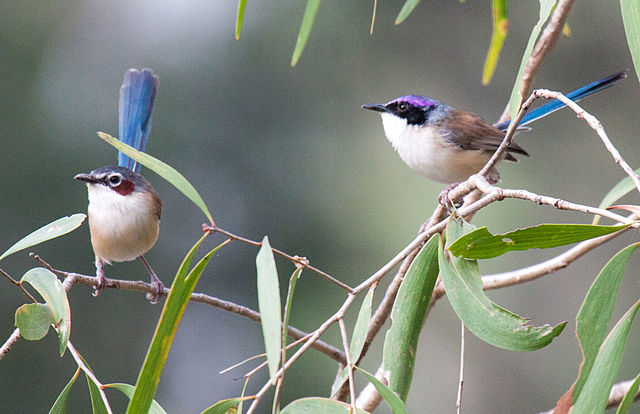Subordinate works not always equally hard

Purple-crowned fairywrens living with breeding parents often help raise offspring. A subordinate works hardest when father or mother has a new, valuable partner, Niki Teunissen and colleagues show.
The number of territories available is limited for purple-crowned fairywren, a small passerine bird that lives in northern Australia in dense vegetation along rivers and creeks. The territories are linearly aligned, are kept all year round and are all occupied. Out of necessity, young birds often stay with their parents for a few years; most breeding pairs have a few male and female subordinates around them. Purple-crowned fairywrens, Malurus coronatus, eat insects; males have a beautiful purple crown during the breeding season.
Subordinates can assist the breeding pair during the busiest time, the two weeks when the young need to be provisioned. But not all of them offer help, and not all helpers work equally hard. Group members that don’t help are still allowed to stay in the group. Niki Teunissen and colleagues investigated under which circumstances group members do or do not help well. They show that a purple-crowned fairywren subordinate ‘knows’ precisely when it pays to be helpful.
The researchers provided birds with colour rings to make them individually recognizable and of each bird, they knew its parents and its brothers and sisters. They observed the behaviour of fifty groups during three breeding seasons.
Brothers and sisters
If young in the nest have the same parents as a subordinate, or share one parent with it, that subordinate will help feed them. And that is worth the effort. Because with help, more young fledge per clutch on average. A helper shares in this greater success, because those young are full siblings or half-siblings. But in the few years that children stick around, both parents may have died or disappeared and been replaced. And sometimes young birds do not join their parents, but another couple. In such cases, the young are unrelated and a subordinate will not help raise them.
Kinship with the young does not fully explain the willingness to help, though, because, on average, group members work harder for a clutch of half-brothers and half-sisters than for a clutch of full brothers and sisters. That seems enigmatic, but something else is going on. Whether a subordinate will support a breeding pair and how hard it will work, also depends on the value that the pair itself has.
Main prize
When both the breeding male and female are not its parents, it is not going to help feed the young, as we already saw. If both are its parents, it will help; the young are then full siblings. Thanks to this help, the parents reduce their workload. Their chance of survival increases, and so does the chance that a new clutch of brothers and sisters will be produced. This is also a win for the helper.
Things get interesting, the researchers discovered, when one parent is gone and the other parent has a new partner. How hard a resident purple-crowned fairywren will work now depends on which parent is left: the same-sex parent or the other one.
A female purple-crowned fairywren living with her mother and her new partner works much harder than a subordinate in a group with both parents. That is because that new male partner is interesting. If her mother dies, the helper may inherit her place and her partner, become the owner of the territory and produce the next clutch. That’s the main prize!
With a father and a new partner, she has less to gain. That new female partner is of no use to her, in fact: she is a rival if a new male ever comes into play. So, she works less hard.
Likewise, a male fairywren puts in most effort in helping when living with a father with a new partner.
Sophisticated
And therefore, a subordinate purple-crowned fairywren works hardest when the breeding pair consists of a parent and a potential mate – which is very sophisticated. Such couple has great value to him or her. That is why he or she often helps provisioning a nest with half-siblings more intensively than a nest with full siblings.
In line with this, the researchers had previously shown that a young purple-crowned fairywren is less willing to join a group with a same-sex stepparent. Subordinates affiliate with parents and a potential mate. Also, when they help defend the nest against predators, it is to protect (half)siblings as well as parents and a potential mate.
Willy van Strien
Photo: Female (left) and male purple-crowned fairywren. P. Barden (Wikimedia Commons, Creative Commons CC BY 4.0)
Sources:
Teunissen, N., M. Fan, M.J. Roast, N. Hidalgo Aranzamendi, S.A. Kingma & A. Peters, 2023. Best of both worlds? Helpers in a cooperative fairy-wren assist most to breeding pairs that comprise a potential mate and a relative. Royal Society Open Science 10: 231342. Doi: 10.1098/rsos.231342
Teunissen, N., S.A. Kingma, M. Fan, M.J. Roast & A. Peters, 2021. Context-dependent social benefits drive cooperative predator defense in a bird. Current Biology 31: 4120-4126. Doi: 10.1016/j.cub.2021.06.070
Teunissen, N., S.A. Kingma, M.L. Hall, N. Hidalgo Aranzamendi, J. Komdeur & A. Peters, 2018. More than kin: subordinates foster strong bonds with relatives and potential mates in a social bird. Behavioral Ecology 29: 1316-1324. Doi: 10.1093/beheco/ary120
Kingma, S.A., M.L. Hall, E. Arriero & A. Peters, 2010. Multiple benefits of cooperative breeding in purple-crowned fairy-wrens: a consequence of fidelity? Journal of Animal Ecology 79: 757-768. Doi: 10.1111/j.1365-2656.2010.01697.x